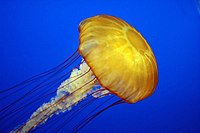
Photo from wikipedia
Abstract This study investigates the possible pathways for Pelagia noctiluca intrusions over the shelf to understand the interactions between jellyfish and fish larvae. To assess how the presence of P.… Click to show full abstract
Abstract This study investigates the possible pathways for Pelagia noctiluca intrusions over the shelf to understand the interactions between jellyfish and fish larvae. To assess how the presence of P. noctiluca may influence populations of Engraulis encrasicolus and Trachurus trachurus, we analyzed the effect of environmental conditions on the abundance and spatial distribution of P. noctiluca, medusae and ephyrae, and early life stages of these two fish species along the Catalan coast. The highest concentrations of P. noctiluca were found offshore, all along the Northern Current path. Their occurrence over the shelf was associated with intrusions of open sea waters that contoured anticyclonic eddies generated by the oscillatory behaviour of the current. Anchovy larvae were found widely over the shelf, but were especially abundant in the north and in waters influenced by the Ebro river. Spatial patterns of anchovy larvae were defined better by physical environmental factors than by the presence of P. noctiluca, whose distribution clearly was determined by the circulation. The differences in environmental conditions controlling the populations of P. noctiluca and E. encrasicolus larvae prevent their general coexistence over the shelf and prey-predator interactions remained limited to the areas affected by offshore intrusions. It is remarkable that the occurrence of T. trachurus larvae and juveniles was limited to locations over the shelf where jellyfish were observed and never offshore. This suggests that the association between fish and jellyfish occur once jellyfish have been advected from offshore towards the shelf, favouring the survival of larvae and juveniles of T. trachurus.
Journal Title: Journal of Marine Systems
Year Published: 2018
Link to full text (if available)
Share on Social Media: Sign Up to like & get
recommendations!